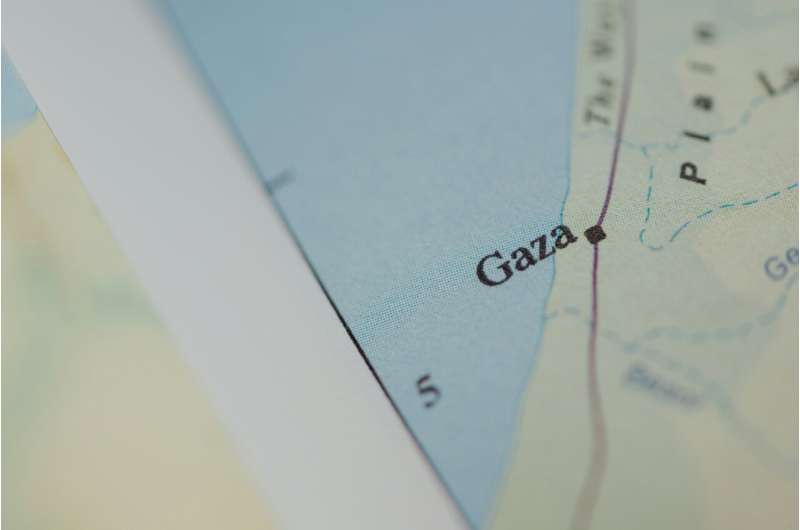This article has been reviewed according to Science X's editorial process and policies. Editors have highlighted the following attributes while ensuring the content's credibility:
fact-checked
trusted source
proofread
New study reveals substantial carbon emissions from the ongoing Israel-Gaza conflict

A new study by an international team of researchers has revealed the significant environmental impact of the ongoing Israel-Gaza conflict. Co-authored by Dr. Benjamin Neimark, Senior Lecturer at Queen Mary University of London, the study provides a comprehensive estimate of the greenhouse gas emissions resulting from the conflict and calls for mandatory military emissions reporting.
The study, titled "A Multitemporal Snapshot of Greenhouse Gas Emissions from the Israel-Gaza Conflict," estimates that the emissions from the first 120 days of the conflict alone were greater than the annual emissions of 26 individual countries and territories. When factoring in war infrastructure built by both Israel and Hamas, the total emissions increase to more than those of 36 countries and territories.
Key findings
- Immediate emissions: The emissions from the first 120 days of the Israel-Gaza conflict exceeded the annual emissions of 26 individual countries. This period saw intense military activity, including bombing raids, reconnaissance flights, and rocket attacks.
- Infrastructure impact: When factoring in the emissions from the construction and fortification of war infrastructure by both Israel and Hamas, such as the Hamas tunnel network and Israel's protective "Iron Wall," the total emissions surpass those of over 36 individual countries.
- Reconstruction emissions: The emissions associated with rebuilding Gaza are projected to be higher than the annual emissions of over 135 countries, equating them to those of Sweden and Portugal.
- Coal comparison: The upper estimate of emissions from pre-war, wartime, and post-war activities is comparable to the burning of 31,000 kilotonnes of coal, enough to power about 15.8 coal-fired power plants for a year.
- Call for reporting: The study underscores the urgent need for mandatory military emissions reporting through the UN Framework Convention on Climate Change (UNFCCC) to better understand and mitigate the climate impact of conflicts.
Study overview
The research estimates the carbon emissions of the Israel-Gaza conflict across three distinct periods: the preparatory construction activities before the conflict, the emissions from the first 120 days of active warfare (October 2023—February 2024), and the projected emissions from future reconstruction efforts in Gaza.
The total emissions from direct war activities in the first 120 days are estimated to be between 420,265 and 652,552 tonnes of carbon dioxide equivalent (tCO2e). This figure rises dramatically when considering pre-war and post-war construction activities, reaching between 47,669,097 and 61,443,739 tCO2e.
Human and financial costs
The study comes in the wake of devastating human and financial losses. Since the onset of the conflict on October 7, 2023, over 35,000 Palestinians and 1,139 Israelis have died, and more than 100 Israelis and foreign nationals are still held hostage by Hamas.
Approximately 54–66% of Gaza's buildings, including homes, schools, mosques, and hospitals, have been destroyed or damaged. The financial cost to Israel is estimated to reach up to $50 billion, including the reconstruction of Gaza, with the World Bank estimating $18.5 billion in damages to physical structures alone.
Climate and conflict
While the humanitarian crises dominate global attention, the environmental impact of the conflict is significant and warrants attention. Military operations, according to a previous study, are responsible for about 5.5% of global carbon emissions, yet these emissions are often underreported and understudied. The research team advocates for better methodologies to track and report these emissions, emphasizing the importance of including wartime emissions in climate calculations.
Co-author, Dr. Benjamin Neimark, Senior Lecturer at Queen Mary University of London, emphasized the importance of this research in drawing attention to the environmental consequences of war, "The study highlights the need for comprehensive reporting of military emissions to the UNFCCC and an increased awareness of the climate impact of conflicts. As the world grapples with the dual crises of climate change and military conflicts, understanding and mitigating the environmental impact of warfare is crucial."
Co-author, Dr. Patrick Bigger, research director of the Climate and Community Project, a climate justice think tank based in the United States, says, "The carbon emissions associated with Israel's invasion of Gaza are not the most important reason that the global community should be pushing for a ceasefire- every single life still at risk is important. But this research demonstrates some of the long run social and environmental impacts of war, serving as a reminder that armed conflict brings us closer to the precipice of catastrophic warming."
The researchers hope their work will prompt further studies and policy changes to address the significant, yet often overlooked, climate costs of war.
More information: A Multitemporal Snapshot of Greenhouse Gas Emissions from the Israel-Gaza Conflict. www.qmul.ac.uk/busman/media/sb … Carbon_Emissions.pdf
Provided by Queen Mary, University of London




















